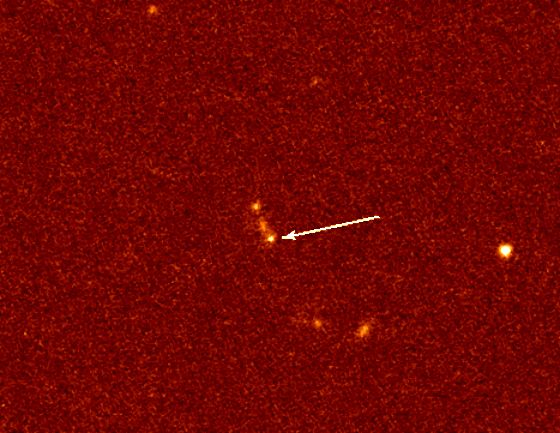Credit & Copyright: HST Image: D.W. Fox, J.S. Bloom, S.R. Kulkarni
(Caltech), et al.
XMM Result: J.N. Reeves, D. Watson, J.P. Osborne (University of Leicester), et al.
Explanation:
What causes the mysterious
gamma-ray bursts?
Indicated in this
Hubble Space Telescope exposure of an otherwise
unremarkable field in the constellation
Crater, is the dwindling
optical afterglow of a gamma-ray burst first
detected
by the Beppo-SAX satellite on 2001 December 11.
The burst's host galaxy,
billions of light-years distant, is the
faint smudge extending above and to the left of the afterglow position.
After rapidly catching the
fading
x-ray light from the burst with
the orbiting XMM-Newton
observatory, astronomers are
now reporting
the telltale signatures of
elements
magnesium, silicon,
sulphur, argon, and calcium - material most likely found in an
expanding debris
cloud produced by the explosion of a massive star.
The exciting result
is evidence that the gamma-ray burst itself
is linked to a very energetic supernova
explosion
which may have
preceded the powerful
flash of gamma-rays by up to a few days.
XMM Result: J.N. Reeves, D. Watson, J.P. Osborne (University of Leicester), et al.
1999 2000 2001 2002 2003 2004 2005 2006 2007 2008 2009 2010 2011 2012 2013 2014 2015 2016 2017 2018 2019 2020 2021 2022 2023 2024 2025 |
Yanvar' Fevral' Mart Aprel' Mai Iyun' Iyul' Avgust Sentyabr' Oktyabr' Noyabr' Dekabr' |
NASA Web Site Statements, Warnings, and Disclaimers
NASA Official: Jay Norris. Specific rights apply.
A service of: LHEA at NASA / GSFC
& Michigan Tech. U.
|
Publikacii s klyuchevymi slovami:
GRB 011211 - gamma-ray burst - supernova - gamma-vspleski - Sverhnovye
Publikacii so slovami: GRB 011211 - gamma-ray burst - supernova - gamma-vspleski - Sverhnovye | |
Sm. takzhe:
Vse publikacii na tu zhe temu >> | |
